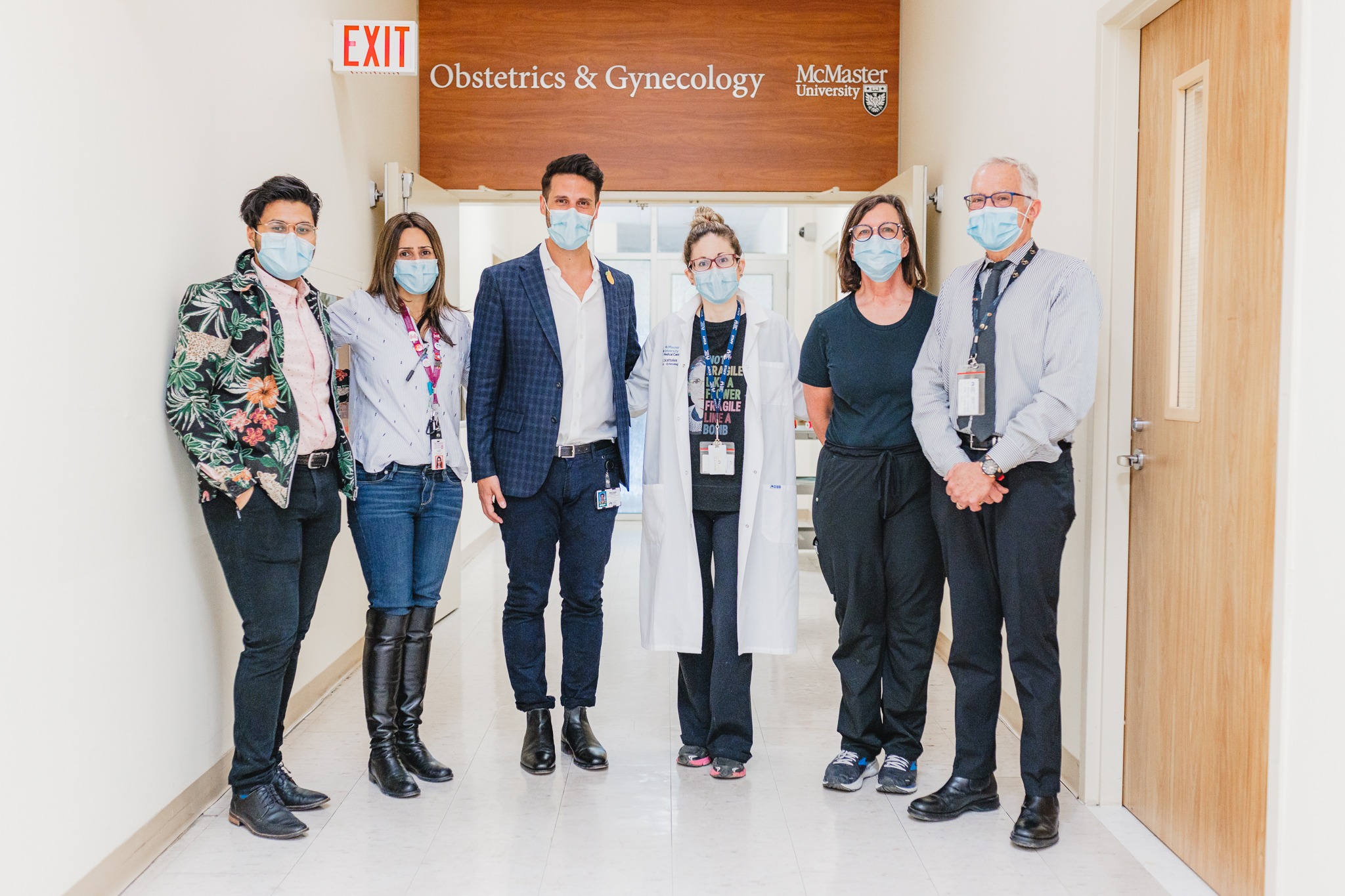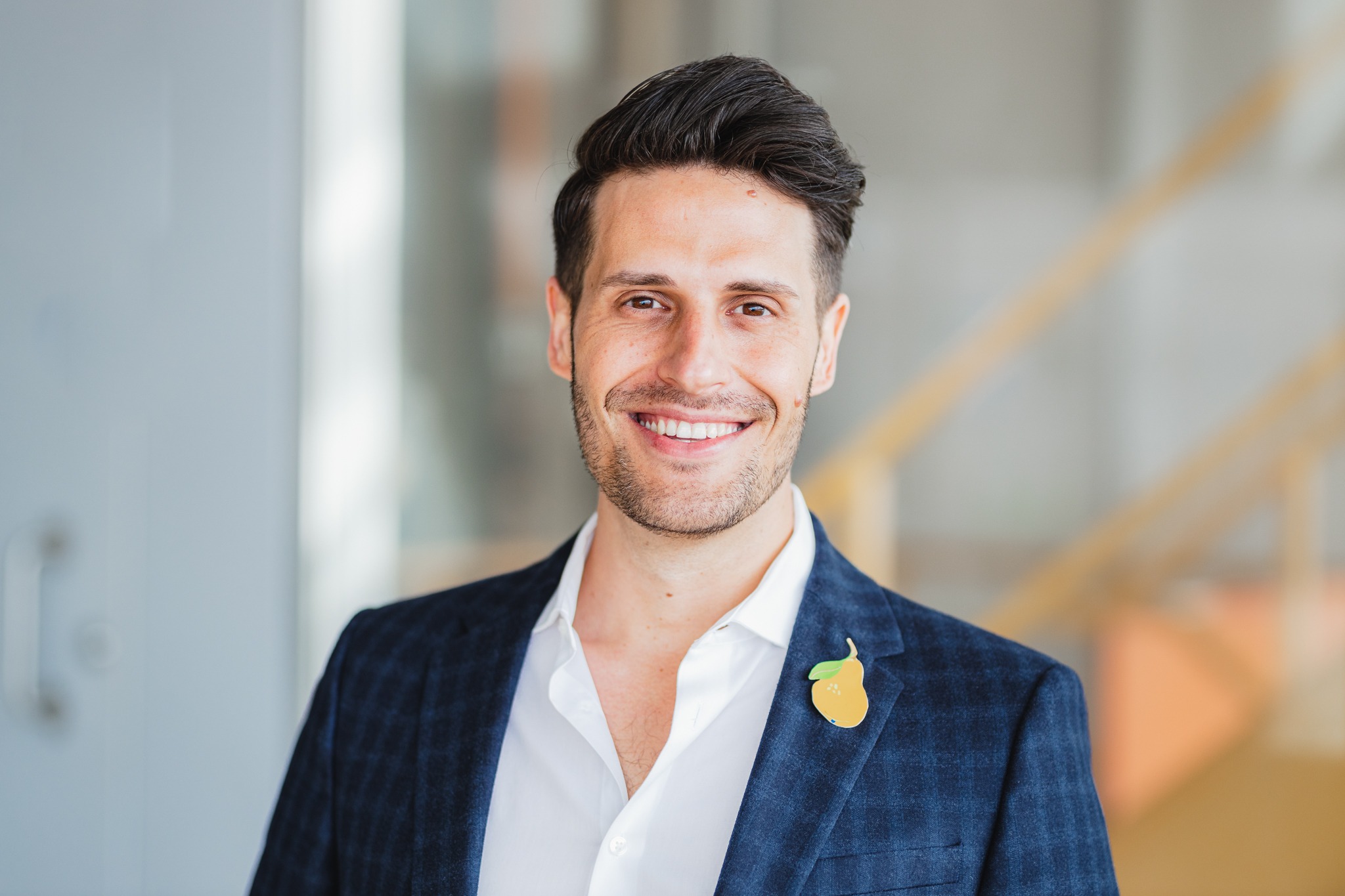
Revolutionary combination of scanning and surgery helps endometriosis patients
Moyo Browne, 28, has had painful periods for as far back as she can remember, which later turned into severe abdominal pain. When she was able to meet with a gynecologist at Hamilton Health Sciences’ (HHS) McMaster University Medical Centre (MUMC) for treatment, her quality of life drastically improved. It was a long road to get there, culminating in a successful 13-hour surgery to remove endometriosis tissue and end the debilitating pain, thanks to a new model of care that brings a whole team of surgeons to the table.
Endometriosis is a condition where tissue similar to the lining of the uterus grows outside of the uterus and causes severe pelvic pain and other serious symptoms. Sometimes the disease is confined to the pelvic area, but it can also spread to other parts of the body.

Dr. Mathew Leonardi
“Bowel endometriosis is incredibly common,” says Dr. Mathew Leonardi, gynecologic surgeon sonologist at HHS. “Bladder and ureter endometriosis are less common, but we still see a high number of cases affecting these parts of the body, since the majority of what we manage at HHS are complex endometriosis cases. We also manage endometriosis cases involving the diaphragm and the lung.”
Endometri – what?
Endometriosis affects ten per cent of people assigned female at birth, or an estimated over one million Canadians.
Traditionally, it has been a tricky disease to see on ultrasounds. It can spread to parts of the body like the bowel or ureters, which a patient and their doctors may not be aware of before going into surgery.
This means one of two things can happen: Sometimes, endometriosis tissue isn’t removed from all areas, resulting in an incomplete surgery. Or, endometriosis may be removed from all areas, but the extent of the surgical procedure may be an unknown before surgery.
“This new model will most certainly enhance patient care tremendously.”
At MUMC, our expert team of surgeon sonologists (doctors who have additional surgical and ultrasound training) have the diagnostic imaging skills to see exactly where endometriosis tissue has spread before surgery so they are better prepared during surgery to remove it. Because of this, our team is spotting endometriosis in other areas of the body quite regularly, and proactively scheduling in the appropriate surgeons to join the surgery and remove it.
In addition to gynecology, surgery can include doctors who specialize in urology, colorectal and thoracic (related to the lung) care.
“When endometriosis is in multiple areas, the surgery is longer, more complex, and requires more resources,” says Leonardi.
Surgery that requires two or three services can take anywhere from six to 14 hours.
Patients meet with the different surgeons for a consultation before surgery, and the surgery day is scheduled as a joint case between different surgical services.
A long and painful journey
In university, Browne reported pelvic pain to her doctor and was prescribed birth control pills to manage it.
“I was an international student and so focused on my grades in school. I didn’t know that you had to go through your family doctor to get a specialist. I should have pushed more,” she says.

When she was feeling down, Moyo would journal to express her feelings.
Over the next two years, between care in Hamilton and care back home in Nigeria, she was prescribed pain medication, had a kidney stent put in to help pass urine, had a colostomy and colostomy reversal, had ovarian cysts removed and a procedure to remove adhesions between her uterus, bladder and ovaries, a common consequence of endometriosis.
It was a flare up in September 2023 that finally brought her some hope.
Browne visited the emergency department at HHS’ Hamilton General Hospital for extreme abdominal pain. Upon suspicion of endometriosis, her ultrasounds were sent to Leonardi to look at, and within two weeks, his office at MUMC called her to book an appointment.
After further ultrasounds, Leonardi confirmed she had a severe case of endometriosis involving the bowel and ureters, and she needed another urgent surgery – and this one would be long and save her kidney, which was slowly dying due to endometriosis compressing the ureter.
Anything but benign
Leonardi joined HHS in 2020 and created the first formal sonologist role within the gynecology department. He has improved how surgeries are planned using advanced imaging and drawing on the expertise of other surgical teams as needed. Now, there are three expert surgeon sonologists at HHS, including Drs. Sarah Scattolon and Jayesh Tigdi.
“We have intimate knowledge of the anatomy, disease, and patient’s symptoms.”
“Endometriosis is usually ignored as a ‘benign’ disease. But it is anything but benign from the perspective of how it negatively impacts peoples’ lives,” says Leonardi. “This new model will most certainly enhance patient care tremendously.”
In this model of care, the doctors both scan and operate. “We have intimate knowledge of the anatomy, disease, and patient’s symptoms,” says Leonardi. “The combination of scanning and surgery is revolutionary.”
On the road to recovery
Browne has been through a lot. She wants women’s pain to be taken seriously.
“I can’t tell you how many times I’ve cried – morning, day and night,” she says.
While her surgery at HHS was considered successful, she still experiences flare ups now and then.
She had a temporary ileostomy to allow her intestine to rest and recover after surgery. An ileostomy creates an opening from the last part of the small intestine to the outside of the body. Just last month, she had a procedure to close the ileostomy.
Unfortunately, both of her fallopian tubes had to be removed during surgery, so she will have to have children through other means if she chooses to. “It broke my heart,” she says, “but the doctor told me about IVF programs and other things to look into.”
The health care team has also shared resources to get in touch with others going through something similar.
“It’s really important to have a doctor who listens and cares,” says Browne. “Dr. Leonardi isn’t the first gynecologist that I spoke with. It’s one thing to get a gynecologist but another to get one who specializes in endometriosis so you feel like you’re being heard and you don’t feel like you’re over-explaining yourself, especially if you’re moving from one doctor to another.”
She says the doctors and staff at MUMC have been tremendous.
“You want to find a doctor who genuinely enjoys what they’re doing and Dr. Leonardi does. You want to have that kind of person on your side — someone who is continually learning, evolving, someone who is taking the time to learn more about their practice. My quality of life is much better. I’m really grateful.”


